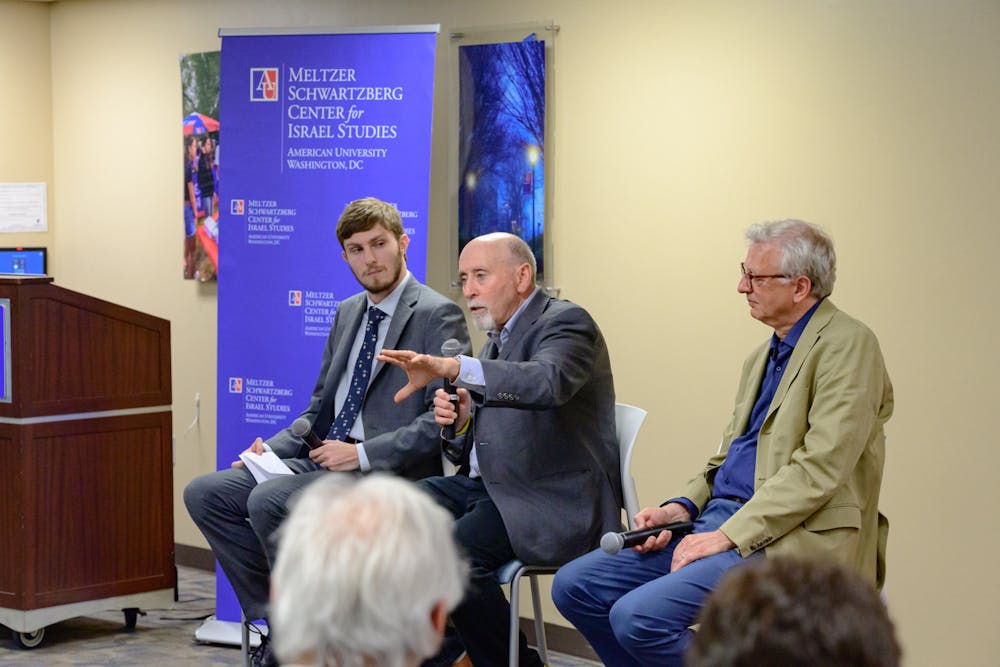Israeli environmentalist Alon Tal, during his March 31 lecture in Butler Pavilion, stressed the importance of regional allyships and cooperation across diverse populations when tackling environmental issues in the Middle East.
People should examine issues around climate change, biodiversity and access to water resources through “a regional context,” Tal said, adding that cooperation between different countries in the Middle East is essential to the success of environmental projects.
The American University Meltzer Schwartzberg Center for Israel Studies organized the event. Center director and professor Michael Brenner said at the lecture that the Center’s responsibility is “to teach critically about Israel.”
“We present Israel in all its diversity, which includes all of its Jewish citizens and also to 20 percent of its Palestinian citizens,” Brenner said. “And we bring a variety of speakers from all these backgrounds to campus.”
When it comes to diversity not only in Israel but also in the Middle East, Tal said it is possible for different populations to work together and share similar values. He drew upon his experiences as a member of the Israeli delegation that created the organization EcoPeace at the Arava Institute for Environmental Studies.
“It was an extraordinary experience because the young students who came there all took this great leap of faith ... in particular the Arab students. And eventually as they left their stereotypes at the door, began to see things,” Tal said. “They saw that they basically had the same values. They all wanted to breathe in clean air, cared about biodiversity, thought that it would be a good thing if there’d be peace in the region.”
Tal primarily focused on how increasing water scarcity is a growing issue in the Middle East.
Swedish hydrologist Malin Falkenmark developed a starting point for future research that measures the threshold of water scarcity. She proposed that countries with less than 1700 cubic meters of renewable freshwater per capita each year experience water stress. This method of measurement was coined the Falkenmark Indicator.
Using the index, Tal said that many countries in the Middle East are water-stressed.
“There are certain countries which are already utilizing more water than is replenished by natural sources,” he said.
Tal said these countries do so by using aquifers, porous layers of rock that can transmit groundwater.
Tal said Israel formally agreed to allocate specified quantities of water to Palestinian communities under the Oslo II Accord, the 1995 Interim Agreement on the West Bank and the Gaza Strip negotiated between the Israeli government and the Palestinian Liberation Organization. Under this agreement, the parties divided the West Bank into three sections: Area A, controlled by the Palestinian Authority; Area B, under Israeli military and Palestinian civil control; and Area C, controlled by the Israeli government.
Tal mentioned how the Oslo II Accord also recognized Palestine’s water rights in the West Bank and founded the Joint Water Commission. As part of the interim agreement, the Israeli government said it would allocate a total 118 million cubic meters of water from the Eastern, North-Eastern and Western aquifers to communities in the West Bank, as stated in Schedule 10 of the Oslo II Accord. Under the agreement, Israelis and Palestinians share access to these aquifers.
Tal clarified that this water has not been reaching Palestinian homes.
“Water comes into Palestinian cities and leaks out before it reaches people’s houses,” Tal said.
“It’s just a waste because the necessary investment in infrastructure hasn’t taken place.”
Tal spoke about desalination, the process of removing minerals and salts from water to make it fit for irrigation and human consumption and highlighted Israel’s reliance on it, with the country utilizing five desalination systems today.
Tal said that these plants have minimally, and even beneficially, impacted marine life in the Mediterranean Sea by supplying extra nutrients, which is important because the sea is nutrient-deficient.
According to Tal, desalination systems tax the electricity grid because every new plant requires electricity comparable to a town of 55,000 people, so “It’s not nothing. ... If we don't decarbonize the grid, we're going to be in trouble.” Tal added, “It also makes us vulnerable, first of all to the price of energy,” explaining that these systems can be wasteful because 40 percent of the energy Israel uses goes toward desalination.
“It’s not an unbelievable amount, but we’re in an age where we need to get to net zero and cut back on our energy footprints,” Tal said.
Tal noted that anyone can locate where all five desalination plants are installed, leaving them exposed to attack. He said because 90 percent of Israel’s drinking water comes from desalination, the possibility of those plants being targeted makes the Israeli population “very vulnerable.”
Tal said that through territorial collaboration, Middle Eastern countries can follow through on key environmentalist pursuits.
“We need to realize that our ability to cooperate with our neighbors is to some extent depending on our healthy relations with them, and one of the reasons we don’t have healthy relations, let's be honest, is that some of [Israel’s] neighbors are not very friendly people,” Tal said. “So when you have a Hamas government ruling Gaza, there’s just absolutely no way you’re going to make progress environmentally.”
During the Q&A, an audience member brought up an incident in which Israelis poured cement into a Palestinian water well, asking for Tal’s thoughts on the matter.
“The sooner we get rid of [the current Israeli] government and bring back a little bit of decency and of course rule of law, we’ll be better off,” Tal said.
Tal ended the lecture with a call to action.
“Remember that the environment and our challenges is far too important to be left as a spectator sport,” Tal said. “We need players. So whether it’s ... being involved here in amazing programs at American University for the environment, let’s all do our part.”
This article was edited by Payton Anderson, Tyler Davis and Walker Whalen. Copy editing done by Luna Jinks, Olivia Citarella, Sabine Kanter-Huchting, Ariana Kavoossi and Hannah Langenfeld.





